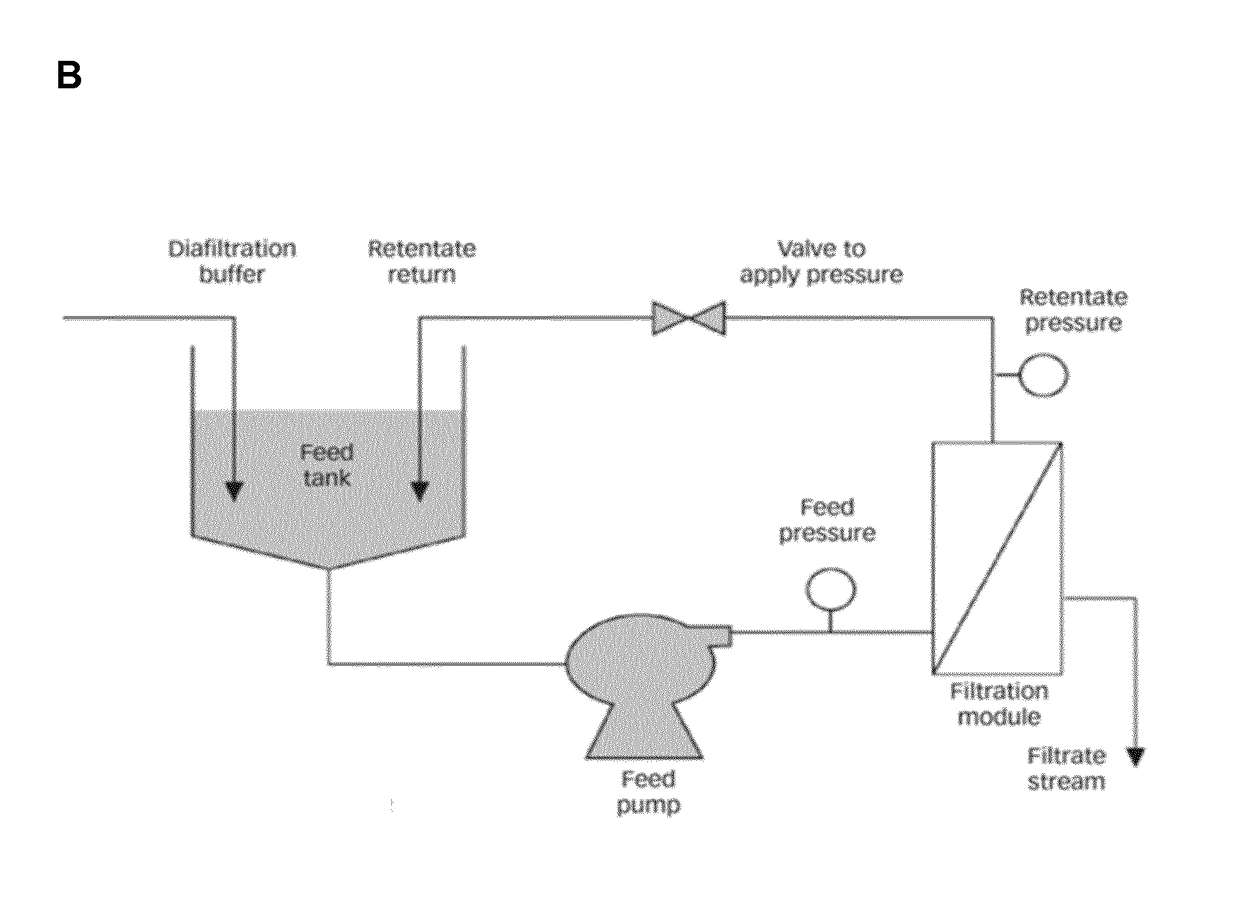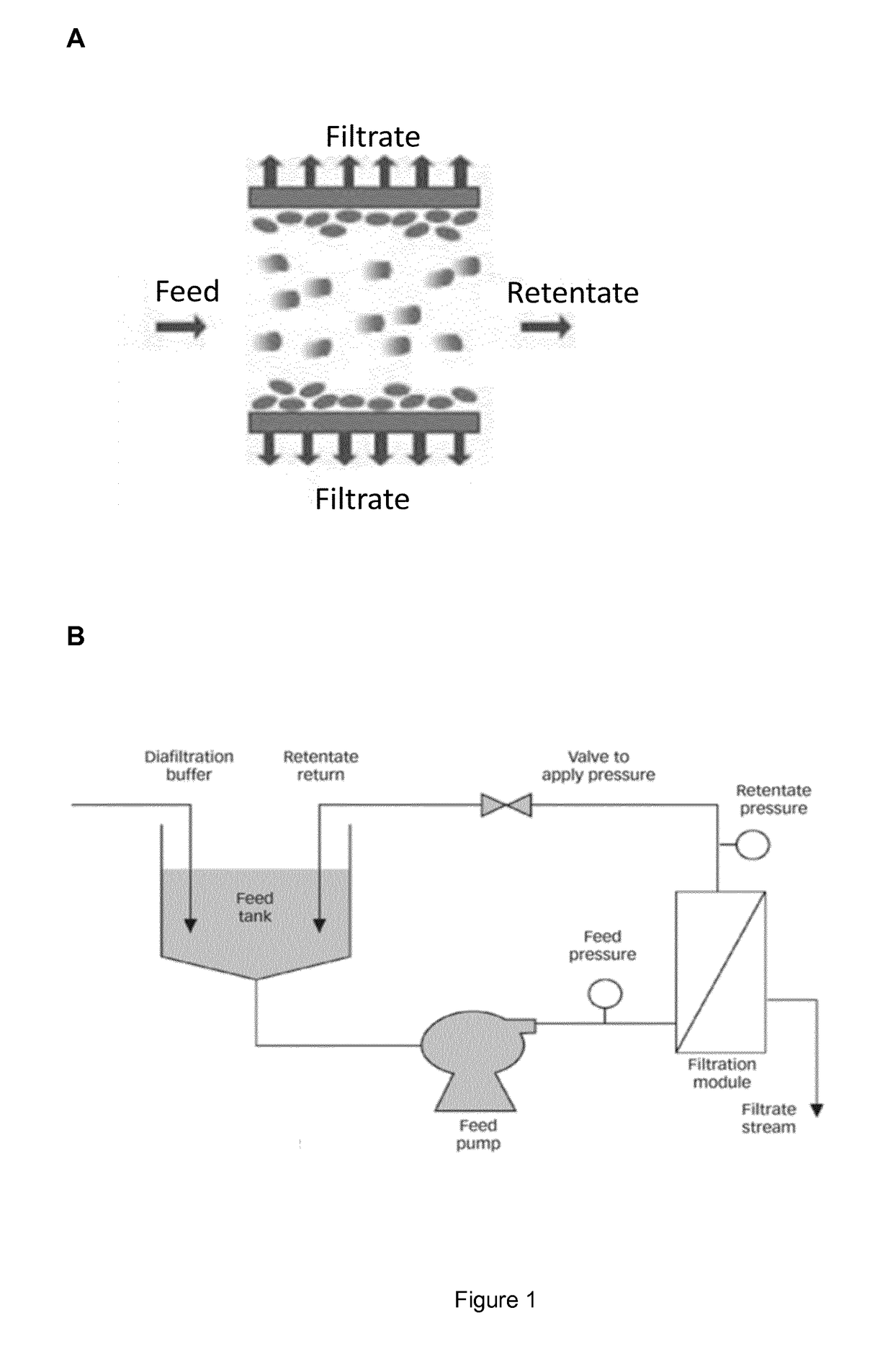A method for producing and purifying rna, comprising at least one step of tangential flow filtration
- Summary
- Abstract
- Description
- Claims
- Application Information
AI Technical Summary
Benefits of technology
Problems solved by technology
Method used
Image
Examples
example 1
[0357]The following materials of Table 1 were used in the subsequent experimental section:
TABLE 1MaterialsEquipmentManufacturerVivaflow 50, PES, 100 kDaSartoriusSartocon Slice 200 100 kDa, PESSartoriusSartocon Slice 200 100 kDa, HydrosartSartorius(cellulose-based membrane)Sartcocon Slice 200 300 kDa, PESSartoriusOmega Centramate T OS100T02, PES 100 kDaPALL GmbHNovaSet-LS ProStream (Low BindingNovaSepmPES), 100 kDaHollow fibre module, 100 kDa, PESGE-HealthcareSpin-Filter Nanosep ® (100 kDa), PESPall GmbHSpin-Filter Nanosep ® (300 kDa), PESPall GmbHSpin-Filter Nanosep ® (1000 kDa), PESPall GmbHSpin-Filter Vivaspin ® 500 (100 kDa), PESSartoriusSpin-Filter Vivaspin ® 500 (300 kDa), PESSartoriusSpin-Filter Vivaspin ® 500 (1000 kDa), PESSartoriusVivaflow 50 Modul, PES, 100 kDaSartoriusSartoflow Slice 200, PES, 100 kDaSartorius
General Methods
example 2
tion of Plasmid DNA
[0358]The following conditions were used for linearization of the plasmid DNA:
[0359]1 μg plasmid DNA
[0360]0.5 μl reaction buffer
[0361]3 Units restriction enzyme EcoRI
[0362]Add. 5 μl with WFI (water for injection)
[0363]The reaction was incubated for 3 hours at 37° C. and stopped by heat-inactivation of the restriction enzyme (65° C., 30 minutes).
example 3
escription of the TFF Process
[0364]All tubes and the retentate vessel were cleaned with 75% EtOH and water and were assembled. The membrane cassette was fixed into the corresponding holder, according to the manufacturer's instruction, and respectively the hollow fibre membrane was connected to the system. Afterwards, the system and membrane was flushed with at least 1 L water, 1 L 1 M or 0.5 M NaOH for 1 hour (for removal of potential contaminants, like RNases) and was washed again with water, until pH value in the permeate was neutral. Subsequently, the whole system was flushed with water for injection (WFI) or diafiltration solution or buffer.
[0365]3.1—Concentration step
[0366]DNA / RNA-solution was filled into the retentate vessel, and was optionally concentrated to the required concentration, by setting the indicated pressures.
[0367]3.2—Diafiltration Step
[0368]After the optional concentration step, diafiltration was started. Therefore the diafiltration tube was placed into the diaf...
PUM
| Property | Measurement | Unit |
|---|---|---|
| Time | aaaaa | aaaaa |
| Atomic weight | aaaaa | aaaaa |
| Atomic weight | aaaaa | aaaaa |
Abstract
Description
Claims
Application Information
 Login to View More
Login to View More - R&D
- Intellectual Property
- Life Sciences
- Materials
- Tech Scout
- Unparalleled Data Quality
- Higher Quality Content
- 60% Fewer Hallucinations
Browse by: Latest US Patents, China's latest patents, Technical Efficacy Thesaurus, Application Domain, Technology Topic, Popular Technical Reports.
© 2025 PatSnap. All rights reserved.Legal|Privacy policy|Modern Slavery Act Transparency Statement|Sitemap|About US| Contact US: help@patsnap.com



